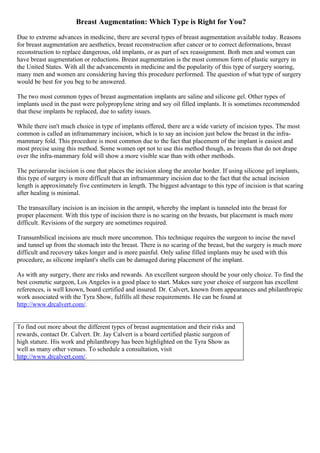Breast Augmentation Which Type Is Right For You
- 1. Breast Augmentation: Which Type is Right for You? Due to extreme advances in medicine, there are several types of breast augmentation available today. Reasons for breast augmentation are aesthetics, breast reconstruction after cancer or to correct deformations, breast reconstruction to replace dangerous, old implants, or as part of sex reassignment. Both men and women can have breast augmentation or reductions. Breast augmentation is the most common form of plastic surgery in the United States. With all the advancements in medicine and the popularity of this type of surgery soaring, many men and women are considering having this procedure performed. The question of what type of surgery would be best for you beg to be answered. The two most common types of breast augmentation implants are saline and silicone gel. Other types of implants used in the past were polypropylene string and soy oil filled implants. It is sometimes recommended that these implants be replaced, due to safety issues. While there isn't much choice in type of implants offered, there are a wide variety of incision types. The most common is called an inframammary incision, which is to say an incision just below the breast in the infra- mammary fold. This procedure is most common due to the fact that placement of the implant is easiest and most precise using this method. Some women opt not to use this method though, as breasts that do not drape over the infra-mammary fold will show a more visible scar than with other methods. The periareolar incision is one that places the incision along the areolar border. If using silicone gel implants, this type of surgery is more difficult that an inframammary incision due to the fact that the actual incision length is approximately five centimeters in length. The biggest advantage to this type of incision is that scaring after healing is minimal. The transaxillary incision is an incision in the armpit, whereby the implant is tunneled into the breast for proper placement. With this type of incision there is no scaring on the breasts, but placement is much more difficult. Revisions of the surgery are sometimes required. Transumbilical incisions are much more uncommon. This technique requires the surgeon to incise the navel and tunnel up from the stomach into the breast. There is no scaring of the breast, but the surgery is much more difficult and recovery takes longer and is more painful. Only saline filled implants may be used with this procedure, as silicone implant's shells can be damaged during placement of the implant. As with any surgery, there are risks and rewards. An excellent surgeon should be your only choice. To find the best cosmetic surgeon, Los Angeles is a good place to start. Makes sure your choice of surgeon has excellent references, is well known, board certified and insured. Dr. Calvert, known from appearances and philanthropic work associated with the Tyra Show, fulfills all these requirements. He can be found at http://www.drcalvert.com/. To find out more about the different types of breast augmentation and their risks and rewards, contact Dr. Calvert. Dr. Jay Calvert is a board certified plastic surgeon of high stature. His work and philanthropy has been highlighted on the Tyra Show as well as many other venues. To schedule a consultation, visit http://www.drcalvert.com/.
